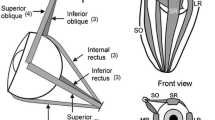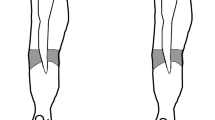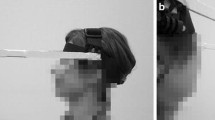Summary
The eyes of the crabLeptograpsus variegatus scan continually when the animal walks. The scanning movements are in the horizontal plane, have an amplitude of between 0.1° and 0.3° and a frequency of about 6 Hz if the animal is surrounded by a bright, contrasting visual field. The scanning movements are abolished if the animal is placed in the dark, or blinded. During scanning the two eyes are predominantly in phase with each other. It is proposed that the scanning is the result of a general increase of activity in the oculomotor neurons during walking, which causes the eyes to oscillate at a frequency which is set by the properties of the optokinetic feedback system. It is suggested that the main function of scanning is to prevent visual adaptation.
Similar content being viewed by others
References
Barnes, W.J.P., Horridge, G. A.: Interaction of the movements of the two eyecups in the crabCarcinus. J. exp. Biol.50, 651–671 (1969)
Bethe, A.: Das Nervensystem vonCarcinus maenas, ein anatomisch-physiologischer Versuch. I. Theil, I. Mittheil. Arch. mikr. Anat.50, 460–546 (1897)
Ditchburn, R.W., Drysdale, A.E.: The effect of retinal movements on vision. I. Step-movements and pulse-movements. Proc. roy. Soc. B197, 131–144 (1977a)
Ditchburn, R.W., Drysdale, A.E.: The effect of retinal movements on vision. II. Oscillatory movements. Proc. roy. Soc. B197, 385–406 (1977b)
Ditchburn, R.W., Ginsborg, B.L.: Vision with a stabilised retinal image. Nature (Lond.)170, 36–37 (1952)
Erber, J., Sandeman, D.C.: The detection of real and apparent motion by the Australian rock crab,Leptograpsus variegatus. II. Electrophysiology. J. comp. Physiol.112, 189–197 (1976)
Franceschini, N., Kirschfeld, K.: Les phénomènes de pseudopupille dans l'oeil composé deDrosophila. Kybernetik9, 159–182 (1971)
Gerrits, H.J.M., Vendrik, A.J.H.: Eye movements necessary for continuous perception during stabilization of retinal images. Bibl. Ophthal.82, 339–347 (1972)
Gregory, R.L., Ross, H.E., Moray, N.: The curious eye ofCopilia. Nature (Lond.)201, 1166 (1964)
Hengstenberg, R.: Das Augenmuskelsystem der StubenfliegeMusca domestica. I. Analyse der ‘clock-spikes’ und ihre Quellen. Kybernetik2, 56–77 (1971)
Horridge, G.A., Burrows, M.: Tonic and phasic systems in parallel in the eyecup responses of the crabCarcinus. J. exp. Biol.49, 269–284 (1968)
Kirschfeld, K.: The resolution of lens and compound eyes. In: Neural principles in vision (eds. F. Zettler, R. Weiler). Berlin-Heidelberg-New York: Springer 1976
Land, M.F.: Movements of the retinae of jumping spiders (Salticidae: Dendryphantinae) in response to visual stimuli. J. exp. Biol.51, 471–493 (1969)
Laughlin, S.B.: Neural integration in the first optic neuropile of dragon flies. I. Signal amplification in dark adapted second order neurons. J. comp. Physiol.84, 335–355 (1973)
Leggett, L.M.W.: Ph.D. Thesis, Canberra 1977
Patterson, J.: The eye muscle ofCalliphora vomitoria L. I. Spontaneous activity and the effects of light and dark adaptation. J. exp. Biol.58, 565–583 (1973)
Pick, B.: Visual flicker induces orientation behaviour in the flyMusca. Z. Naturforsch.29c, 310–312 (1974)
Reichardt, W., Poggio, T.: Visual control of orientation behaviour in the fly. Part I. A quantitative analysis. Quart. Rev. Biophys.9, 311–375 (1976)
Sandeman, D.C.: The nervous control of the eye movements of the shore crab,Carcinus meanas. Ph.d. Thesis, St. Andrews 1963
Sandeman, D.C.: A sensitive position measuring device for biological systems. Comp. Biochem. Physiol.24, 635–638 (1968)
Sandeman, D.C.: Compensatory eye movements in crabs. In: Identified neurons and arthropod behavior (ed. G. Hoyle). New York: Plenum Press 1978
Sandeman, D.C.: Regionalization in the eye of the crabLeptograpsus variegatus: eye movements evoked by a target moving in different parts of the visual field. J. comp. Physiol. (1978)
Sandeman, D.C., Erber, J., Kien, J.: Optokinetic eye movements in the crab I. Eye torque. J. comp. Physiol.101, 243–258 (1975)
Snyder, A.W., Laughlin, S.B., Stavenga, D.G.: Information capacity of eyes. Vision Res.17, 1163–1175 (1977)
Stowe, S., Ribi, W., Sandeman, D.C.: The anatomy of the first optic ganglion in the crabLeptograpsus variegatus. Cell Tiss. Res.178, 517–532 (1977)
Wallace, G.K.: Visual scanning in the desert locust (Schistocerca gregaria Forsk.). J. exp. Biol.36, 512–525 (1959)
Wiersma, C.A.G., Fiore, L.: Factors regulating the discharge frequency in optomotor fibres ofCarcinus maenas. J. exp. Biol.54, 497–505 (1971)
Author information
Authors and Affiliations
Additional information
I thank the members of the Department of Neurobiology for many helpful discussions relating to this study, and Roger Hardie for making the recordings from crab retinula cells, the results of which are referred to in the discussion.
Rights and permissions
About this article
Cite this article
Sandeman, D.C. Eye-scanning during walking in the crabLeptograpsus variegatus . J. Comp. Physiol. 124, 249–257 (1978). https://doi.org/10.1007/BF00657056
Accepted:
Issue Date:
DOI: https://doi.org/10.1007/BF00657056




